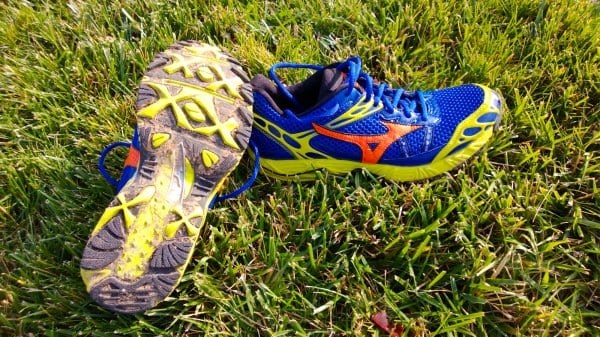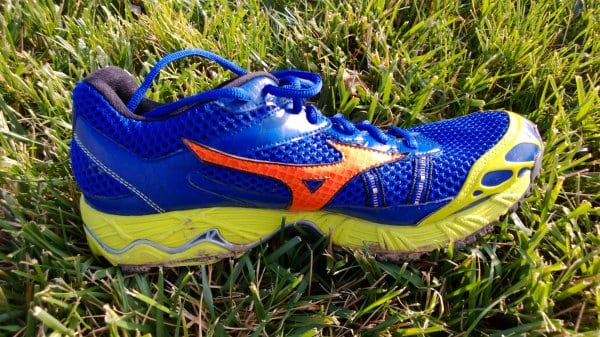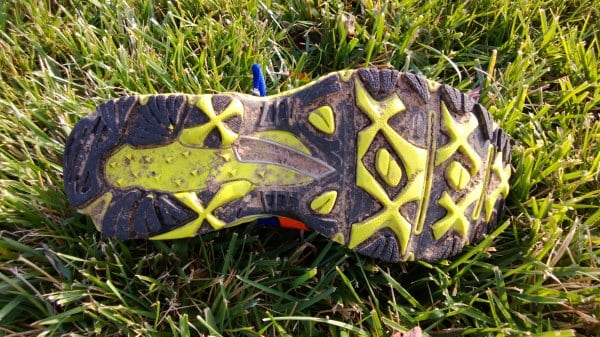Our Favorite Trail Running Shoes
Check out our Best Trail Running Shoes article to learn about our current favorite trail running shoes!
Mizuno Wave Ascend 7 Review
In today’s rapidly changing footwear scene it is rare to see a trail running shoe go through seven iterations. What is even more uncommon is for that shoe to stay close to its roots and not deviate from the original concept. While most running shoe companies are out radically updating uppers and heel-to-toe drop, it is nice to see someone riding the horse that got them to where they are.
The Mizuno Wave Ascend 7 ($105) sticks to the classic trail running shoe formula: good tread, reinforced upper, standard road shoe heel-to-toe drop, underfoot protection, and fitting true to size. This sturdy kick is based off of Mizuno’s lightweight trainer, the Wave Elixir, and it provides a great feel on road and trail. At 11.2 ounces with a 11 mm drop it may not be everyone’s cup of tea, but it has an audience as I see versions of this shoe at every race I’m at.
For a more in depth overview and up close look, check out the video below.
[Click here if you have trouble viewing the above video.]
Mizuno Wave Ascend 7 Review Transcript
Hey and welcome to Trail Trials: the video review section of iRunFar. I’m Travis Liles. In this video, we’re going to take a look at the Mizuno Wave Ascend 7.
In its seventh iteration, the Mizuno Wave Ascend adds some really nice updates. What we’re going to do now is to get up close and personal. We’ll take a look at the upper, the midsole, and some of the new features and tread patterns here on the bottom. Then, we’ll come back at the end with some overall impressions.
Mizuno Wave Ascend 7 – Upper
Let’s start out by talking about the upper on the Mizuno Wave Ascend. Mizuno categorizes it as having a Dynamotion upper – which basically means there are a lot of things here in place to give you a good secure ride on your foot. Some of those things you’re going to see right away are those bands that you’re going to find on each side of the foot. They’re going to help you secure that foot down. They’re going to lock that forefoot in place and keep your foot from sliding around. That was one of the features I really liked about this shoe. I felt like it had a really good, secure fit, so if you’re on nasty terrain or somewhere off camber and you really want that foot locked in, this shoe did a really nice job of it. However, even with that, you have a good, open toe box. A lot of times that’s not the case. A good open toe box, with it being mesh, it lets those toes wiggle around and no weird bands over the top of your foot that might impede or pinch on your toes.
Up front of the toe box, we have some overlays you’re going to see to really round out the toe area. At the very tip or the apex, we’re going to have a hard piece of rubber to keep that real direct impact from taking too much of a hit on your toes.
There is a mud guard all the way around the base of the shoe meaning that that mesh – though it does attach directly to the midsole – there’s an overlay on top of it which is going to add some structure that’s going to keep your foot in a little bit better. It’s also going to give you a little more height stepping in puddles and those sorts of things. You do have a lot of mesh on this shoe. I’ve ran a couple times with this shoe in the rain, and I felt like water could get out; it wasn’t in there sloshing around.
As we move around the shoe, you can really see some more overlays. We have overlays along the upper laces that extend into the back which give a nice tight sort of structure here that’s going to help lock your foot in a lot better. Then around the back, you have a very standard heel. There’s a heel cup in here – it is hard material – but a nice comfortable soft, almost stretchy nylon-feeling interior in here for your foot, hopefully keeping blisters and those kinds of things from popping up.
The laces are a little bit stretchy, which is nice because they kind of bunch up on themselves, but they’re not that sausage shoestring that we’ve seen before. On the inside, we do have that gusseted tongue that doesn’t roll all the way up to the top. It goes roughly to where your tongue loop or lace is here in the middle. So we’re gusseted all the way down keeping the junk from getting inside. As you would expect on standard types of road shoes or even trail shoes anymore, of course you have removable insoles in case you want to put anything in there.
Mizuno Wave Ascend 7 – Midsole
Let’s move onto the midsole. The midsole, as you can see, is kind of one single color here. It’s single density, but what Mizuno does differently than other shoe companies is that they use this thing called the Wave Plate. You can see that silver plastic here and on the other side. The idea of the Wave Plate is, versus having a different chunk of foam in here that’s harder and is a more hard transition from one type of foam to the other, they use this Wave Plate that is varying densities based off of how much pronation control you want. This is for mild to moderate over-pronators. You can see that by the Wave Plate and the height of it.
Then in the back, if you look at the heel, you can see it’s thicker on the inside of the shoe than it is on the outside – meaning when you land, if you’re someone who over-pronated, you’d be in here. This shoe, because of the stack height being taller, is going to push that over to the side. What’s nice is this is good cushy foam. You’re not looking at Hoka-type foam, but this is soft and really takes a lot of the impact from rocks – I felt it did a nice job of absorbing. Of course, the downside of that is going to be the feel of the trail. Obviously you need to weigh those types of options.
Mizuno Wave Ascend 7 – Outsole
When we move to the bottom, this is where Mizuno really made some nice changes, I thought. They added in these really thick “Xs” that extend from the toe all the way to the back in varying patterns. Those are going to give you a lot better traction, of course. Then on the outside or the perimeter of the shoe, you have some angled lugs, angling forward in the front and angling backwards in the back. There are two different types of densities. The black rubber is a harder compound, so that’s probably going to last longer. Also, it’s in your hit points that you’re going to have for your foot. Then the interior type of rubber is smoother and not quite as dense. It will have a little more give to it when you’re climbing and those sorts of things, but it’s not super loose or anything like some lugs are. Overall, it’s a really nice tread pattern on the bottom. Overall, is what you’ve got is 11.2 ounces or 11.4 ounces (depending on where you see it) shoe with about an 11mm drop that can definitely take a beating out on the trail.
Mizuno Wave Ascend 7 – Overall Impressions
The Mizuno Wave Ascend definitely doesn’t fall in line with the current trends of super lightweight, low-profile, minimal type of shoe. This is a mid to heavy weight shoe: lots of protection, good grip, good overall features, and what I really like about it is that it’s something that is a good hybrid shoe. If you’re somebody that travels, you can throw this in your suitcase. It transitions well on the road and it transitions well to trail also, so you don’t have to pack two different pairs.
Overall: good shoe, solid, it’s going to have its audience. It’s probably not for the minimalist folks out there, but definitely anybody looking for something with a little bit more stability, a lot of support, and a solid all-around general purpose trail shoe – I definitely encourage you to check out the Mizuno Wave Ascend 7.
Call for Comments (from Bryon)
If you’ve run in the Mizuno Wave Ascend 7 or another recent Mizuno trail running shoe, please let us know what you thought!



